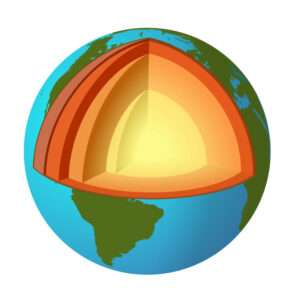Chapter 3 – Interior of the Earth
Welcome to sidclasses.in here we have made available the best class 11 geography ch 3 notes which you can follow to get higher marks in your examination of geography. You will get all the knowledge here based on the NCERT book moreover if you are not from class 11 then you will also benefit from the knowledge of an Earthquake.Get the notes of all chapters here 👈

Sources of information
- Direct Sources – Activities like Mining and Drilling are examples of direct sources, which give information that there is a layering system in the crust. The crust is made of many kinds of rocks and minerals. the other example is Volcanic eruptions which suggest that there is some zone inside the earth that is very hot and in liquid condition.
These Sources are not very reliable as mining and drilling can be performed only up to a limited depth.
- Indirect Sources – Gravitational field, Magnetic field, Seismic waves, Falling meteors, etc are a few examples of indirect sources. Seismic wave movement explains that there are three layers in the earth having different densities each. Their density increases towards the center of the earth.
Earth Quake
The phenomenon of shaking of the earth due to the release of a large amount of energy generates waves that travel in all directions. It is a natural event. Why does the Earth shake?The tectonic plates of the Earth are always moving, but they get stuck at their edges due to the force of friction. When the stress on the edges overcomes the frictional force, it results in the release of a large amount of energy due to which we feel the shaking of the earth, and this phenomenon is known as an Earthquake.
- The point where the energy is released is called the focus/hypocenter and Above the focus point on the surface, it is called the epicenter.
- An instrument called SEISMOGRAPH is used to measure the waves on Richter Scale.
- The Earthquakes take place within the depth of 200km (lithosphere)
What is focus/Hypocenter?The point inside the earth where the earthquake initiates is called the focus. It is always inside the earth within the depth of 100-200 km. What is Epicenter?This is located perpendicular to the earth’s surface, maximum destructions are caused here.
Earth Quake Waves
Following are three types of earthquake waves :
- P or Primary Wave
- S or Secondary Wave
- L or Long or Surface wave
- P and S waves move inside the body of the earth, so they are called “Body Wave”.
- The p wave is the fastest wave of all. It is called a longitudinal wave. These waves move forth and back. These waves move in both liquid and solid.
- S wave moves slower than P waves. It is called a Transverse wave. This kind of wave can only travel in solids.
- L wave is the slowest of all. it moves on the surface of the earth and this wave is the reason for maximum destruction.
What does Cladera mean?
When a Crater (Opening through which magma comes out of magma) is collapsed due to an explosion, this is called Cladera.
What is Mid – Oceanic ridge?
A long hill-like landform is formed when plates move away from each other under the water of the ocean resulting in the rise of magma called Oceanic Ridge.
What is Mercalli Scale?
Its a tool used to measure the destructions caused by earthquakes. It ranges from 1 to 12 and was developed by an Italian Seismologist.
The effects of the earthquakes
- Shaking of the surface of the Earth.
- Tsunamis and Landslides
- Destruction of Public Properties
- Destruction of communication lines
- Damaging of Water reservoirs or Dams
- Fire Accidents
Shadow Zones
There are a few zones where seismic waves don’t reach during an Earthquake. These are called shadow zone. Shadow Zones are formed because of the following reasons –
- Three layers in the earth
- Each layer have different densities
- The liquid state of the mantle
- P Wave Shadow Zone: The seismic waves should travel in a straight path but because of their varying density it moves in a curved path. as a result of which an area around the earth does not record P wave.
- S Wave Shadow Zone: It is a greater zone than the P wave shadow zone. It is caused because the S
wave does not pass through a liquid state (mantle). Therefore, some of the zones around the earth is called S wave shadow zone.
Types Of Earthquakes
- TECTONIC EARTHQUAKE
- NUCLEAR EXPLOSION EARTHQUAKE
- RESERVOIR IMPOUND EARTHQUAKE